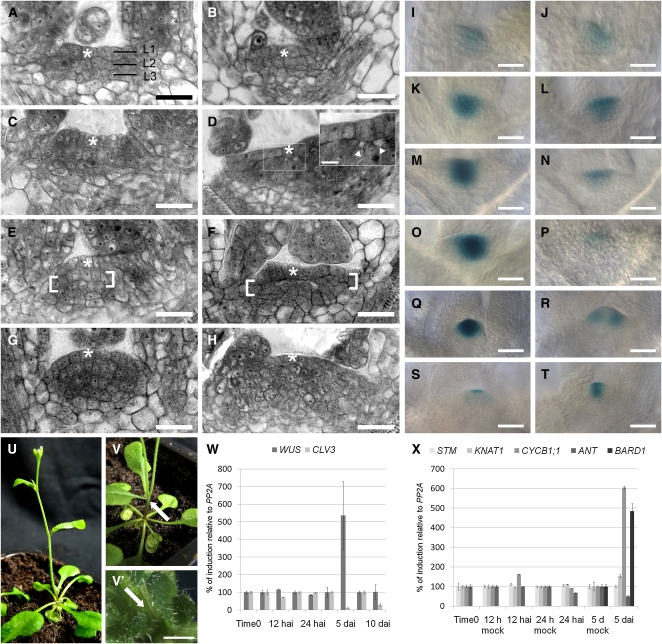Figure 3.
SAM Morphological and Genetic Alterations in β-Estradiol–Treated RBRi Seedlings.
(A), (C), (E), and (G) Resin-embedded, toluidine blue–stained sections of wild-type SAMs from 3-, 4-, 5-, and 7-d-old seedlings, respectively. The apex acquires the dome shape morphology typical of the Arabidopsis SAM. Asterisks indicate the L1 layer.
(B), (D), (F), and (H) Resin-embedded, toluidine blue–stained sections of SAMs from 3-, 4-, 5-, and 7-d-old RBRi plants, respectively, germinated on β-estradiol. Beginning at day 4, morphological changes became visible in mutant SAMs. In the inset in (D), magnification of the boxed area, white arrowheads point to the beginning detachment of L2 from L1. On day 5 (F), the L2 layer became detached from the L1 layer, and disorganized cell divisions were observed in L2 (between square brackets, compare [E] and [F]). On day 7 (H), the L1 layer was still clearly visible, but cell division in L2 and L3 had become disorganized, resulting in the loss of the typical L2 anatomy. Mutant SAMs became flattened by day 5 (F) and afterwards expanded laterally and vertically, possibly because of cell overproliferation in L2 and L3.
(I), (K), (M), (O), and (Q) ProCLV3:GUS staining in untreated 3-, 4-, 5-, 8-, and 15-d-old RBRi; ProCLV3:GUS seedlings. The stronger GUS staining (3 h at 37°C) was necessary to compare the β-estradiol untreated and weakly staining treated RBRi seedlings.
(J), (L), (N), and (P) ProCLV3:GUS staining in 3-, 4-, 5-, and 8-d-old RBRi; ProCLV3:GUS seedlings germinated on β-estradiol.
(R) Thirty percent (n = 60) of the 15-d-old recovered seedlings germinated on β-estradiol developed twin ProCLV3:GUS sectors 1 week after transfer to β-estradiol–free soil.
(S) In rare cases, the ProCLV3:GUS signal remained confined to the L1 layer and no organ production was observed even 1 week after recovery from a 5-d-long β-estradiol treatment.
(T) Most of the seedlings recovered and showed a wild-type-like, although weaker, ProCLV3:GUS staining pattern.
(U), (V), and (V') Thirty percent (n = 60) of the recovered RBRi seedlings produced twin inflorescence stems originating at the first node ([V], arrow points at the bifurcation), or from the basal rosette ([V'], arrow pointing in between the two emerging young inflorescences), while the majority of the recovered RBRi plants had a single inflorescence stem (U).
(W) CLV3 and WUS expression in Arabidopsis RBRi shoot apices quantified by real-time PCR. In 5-d-old seedlings germinated on β-estradiol (n = 50 for each time point/treatment/analyzed gene expression), CLV3 is strongly downregulated, as confirmed by ProCLV3:GUS staining. The CLV3-WUS loop appears to be intact 5 d after RBRi induction because WUS became temporarily upregulated. Ten days after continuous induction, CLV3 expression levels was still reduced, while WUS mRNA levels had returned to nearly wild-type levels. Seedlings treated with β-estradiol for 5 d were arrested in organ production (see Figure 4). The error bars represent the se from two biological replicas and two technical replicas.
(X) Expression of meristem marker genes in Arabidopsis RBRi shoot apices quantified by real-time PCR. STM and KNAT1 RNA levels fluctuated only slightly at 12 and 24 h after RBR downregulation but remained at constant levels 5 d after germination on β-estradiol (n = 50 for each time point/treatment/analyzed gene expression). Consistent with the decreased organ production we observed in RBRi seedlings after β-estradiol treatment (Figure 4), ANT expression levels were downregulated 5 d after RBRi induction. Five days after germination on β-estradiol, CYCB1;1 was upregulated in the SAM, as we observed in leaves (see Figure 5). BARD1 (reported to limit WUS expression; Han et al., 2008), is strongly upregulated 5 d after induction. The error bars represent the se from two biological replicas and two technical replicas.
Bars = 10 μm in (A) to (H), 2.5 μm in the (D) inset, 20 μm in (I) to (V), and 2.5 mm in (V').

